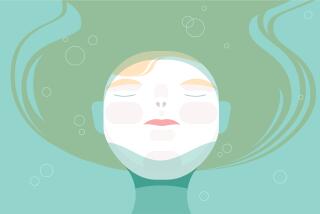The Finnish Woman’s Way to Health, Success, Relaxation--and Glowing Skin
- Share via
In Finland they say that women are at their most glowing and beautiful 30 minutes after taking a sauna. That’s all the reason I need for taking one every chance I get--never mind the fact that it feels divine, particularly when done in the Finnish way.
So on a visit to Helsinki in June, I tried out every sauna I could at hotels, public swimming pools and, above all, at the Finnish Sauna Society on Lauttasaari Island, just west of downtown. There I disrobed, showered and entered the sauna chamber (heated to at least 200 degrees), where I sat on a little white towel, sweating and wondering how long I could take it. Occasionally I poured water from a wooden bucket onto the hot sauna stones, pushing the temperature higher and creating a cloud of steam called loyly. I even bought a switch made of aromatic birch branches known as vihta, which the Finns beat against their limbs to improve circulation.
And when I felt on the verge of passing out, I went outside to take a dip in the frigid Gulf of Finland. Afterward, I sat on a bench on the lawn gazing at the sea. That was the best part of the whole procedure, resting under the blue sky and greening trees, empty of thought and tension, among other women utterly at peace with their naked bodies.
There were no men around because the society is open to men and women at different hours. Though the average Finn wouldn’t dream of wearing a bathing suit into a sauna, sauna-going is a strictly asexual custom. In Finland, men and women rarely take saunas together unless they’re part of a family. Most Finns grow up taking saunas with their parents at least once a week in their homes, apartment buildings and summer houses by lakes or the ocean. Holidays such as Finnish Midsummer can’t really begin until the whole family cleans up for the celebration in the sauna, making it part of their most cherished memories.
The custom, which is 1,000 years old at least, cuts deeper still. Before hospitals were common, Finnish women gave birth in saunas (particularly in winter because they were the warmest and cleanest places around), the sick were healed there and bodies were prepared for burial. Now there are about 1.5 million saunas in Finland (striking, given that the population is slightly more than 5 million). A Finnish epic poem, the “Kalevala,”, refers to saunas repeatedly; there’s a birch vihta on the Finnish one-markka coin; and according to folklore, every sauna has a gnome. Children are advised to behave as if they were in church when in a sauna, underscoring its spiritual aspects. “We have a saying,” says Maria Serenius, the Finnish general consul in Los Angeles. “No ill can reach you when you are in the sauna.”
“The sauna has played an important part in Finnish politics and business as well,” Serenius adds. “The best deals are made in the sauna. You get to be very mellow and are therefore in a suitable mood for compromise. It is also a great equalizer. When you are naked in the sauna, there are no pretensions.”
Of course, for Finnish women in business and politics, this could pose a problem, since sex segregation once threatened to turn the sauna into an old boy’s club, cutting women out of high-level negotiations. But that hasn’t proved an obstacle to sexual equality. In 1906 Finland became the first country in the world to give women full political entitlement, including the right to vote and hold office; women now constitute 37% of the parliament. In 1987 the Finnish Evangelical Lutheran Church approved women for the clergy, and 60% of the doctors in Finland are female. Many of these high achievers have formed women’s sauna clubs to keep healthy, relieve tension and, above all, network.
These days, almost all Finnish women work outside the home. So Finnish mothers are all too familiar with the pressures that come from holding down a job and caring for a family. Dr. Leena Peltonen, who is from Finland and chair of the Department of Human Genetics at UCLA’s School of Medicine, believes that saunas help them cope with the pressures of dual-career lives. “Saunas are relaxing and pleasant--and that’s good for your health,” she says. For those with cardiovascular problems and women late in pregnancy, saunas aren’t advised. Nor is there any positive proof that they are a treatment for fatigue. But in the heat of a sauna, the metabolism speeds up, circulation increases and blood pressure drops. “It’s like returning to the womb of the mother,” Peltonen says.
It’s thought that old-fashioned Finnish smoke saunas--which have a wood-fired stove with rocks, but no chimney--are better for you than electric saunas because their heat isn’t so dry. But they aren’t easy to find outside Finland. At her home in Bel-Air, Consul General Serenius has an electric sauna, though she brought the stones for it from Finland.
Several weeks ago I took a sauna there with the deputy consul, Nicola Lindertz, who told me that her “bachelorette” party was held in a Helsinki sauna and who helped me work up the nerve to jump into the chilly outdoor pool afterward. Back at home, she’s gone cross-country skiing across the frozen Gulf of Finland to a cottage on an island, where she and her companions built a tent sauna and chopped a hole in the ice so they could take a dip. I could never do that. But I bet that’s why her skin is so good.
More to Read
Sign up for The Wild
We’ll help you find the best places to hike, bike and run, as well as the perfect silent spots for meditation and yoga.
You may occasionally receive promotional content from the Los Angeles Times.






